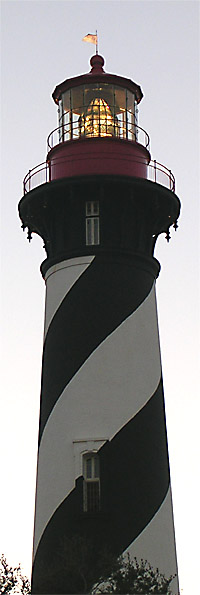St. Augustine Cages Tiger

A local man in a Bengal tiger costume climbed atop the 165-foot-tall St. Augustine lighthouse Tuesday morning, stayed up there four hours and placed a 4Myduke.Com flag on a lightning rod to protest Internet pornography and publicize his children's book.
Frank Feldmann, who's selling a self-published book about Myduke the magic tiger under the pen name Dusty L. Cage, published a "Legal Defense Fund" page on his web site before storming the lighthouse:
If you are visiting this page Myduke probably needs your HELP! As you know cats, even BIG cats, get into trouble and trouble usually means LEGAL EXPENSES! That is usually what happens when someone stands up for what is right. LEGAL EXPENSES. Many Legal Expenses.
If you support Myduke in his quest for Porn and Agenda Free children's entertainment, you can help two ways. Straight out contribution or the purchase of Dusty L. Cage's books. ...
Simply put. In the society we live in, sometimes it is necessary to do things to raise attention that some may see as a nuisance. When in the battle against child porn, unnecessary violence, and popular political agendas it is at times necessary to speak out in ways that may hold a progressively uncaring public's attention.
A parents section on his site contains examples of the porn he's protesting -- sexually explicit illustrations of Disney characters, over which he's added Mickey Mouse in some places to preserve what's left of their dignity:
We together as families, I believe we can stop this. Not only for the protection of our children, but for the protection of our own childhood memories. ...Don't be mad at me for showing this, I'm risking my life to stop this. What are you doing?
Feldmann's been charged with felony burglary and possession of burglary tools over the stunt. His flag's still flying over the lighthouse.
In 2003, he rode a local carousel 52 hours and 15 minutes to support the troops, raise money for the March of Dimes and publicize his children's book.
Mark Pilgrim's Not on Board
Mark Pilgrim offers his long bet on the newly public RSS Advisory Board:I assume the group won't actually accomplish anything; they'll just stumble around like small children running with scissors to catch the short bus until they quietly disband, and we can look forward to doing all of this over again in 2 years. But in the meantime, I regard it as inevitable that the group will eventually try (and fail) to tackle every single one of these issues. (I believe Rogers once called this "the most well-researched flame on the Internet," which is about as close to a compliment as I'm likely to get from him.) But no one will actually dare to link to the article itself, and those who haven't read it (or couldn't finish it because they were too busy spitting bile at their monitor) will wonder where all these test cases came from, and why everyone seems to know so much about this ragtag collection of esoteric issues, and wouldn't it be nice if someone could write all of them down in one place, and someone will volunteer to do exactly that, except he'll want to be all clever-like and do it in OPML, and it will only validate in one of the three OPML validators, and the thread will go off on a long tangent about which validator is "correct", which will itself spawn a separate mailing list, blog, wiki, discussion forum, and advisory board to be hosted at opmlboard.org, which will fork each existing OPML validator and host it locally and then never update it, so they will slowly go out of sync with each original version, which will lead to a total of six OPML validators and a bitter Google PageRank war and lots of wringing of hands about how Google is favoring OPML validators that are not The One True OPML Validator, which is, of course, Radio.
But I'd be happy to be proven wrong.
I don't know how much the board will accomplish, and I'm reluctant to saddle the new members with my own expectations, but I'm encouraged by the early progress on a proposed specification, which if written properly ought to resolve some long-standing issues.
Ultimately, the reason I was eager to see the group go forward (and go public) is because Really Simple Syndication is a ginormously successful format that's going to become more popular after the release of Internet Explorer 7. Thousands of sites use RSS. Businesses are banking on it, including the largest software company in the world.
Considering all of that, how could anyone favor the dissolution of a group that publishes the format's specification and tries to make RSS easier for developers to support?
RSS already lost one patron when Netscape abandoned interest just as syndication was starting to take off six years ago. Losing another today, when syndication formats are about to be introduced to millions of users through Internet Explorer, doesn't make sense.
My Lunch With Tyson Tomko
 When I took the kids to Chick-fil-a for lunch yesterday, we sat down next to this imposing looking man and his family. With his bald head, six-inch-long Fu Manchu goatee and bad-ass tattoos running from wrist to wrist over tree-trunk arms, I'm thinking he had to be one of three things: professional wrestler, rock musician or crazed South Floridian drug lord.
When I took the kids to Chick-fil-a for lunch yesterday, we sat down next to this imposing looking man and his family. With his bald head, six-inch-long Fu Manchu goatee and bad-ass tattoos running from wrist to wrist over tree-trunk arms, I'm thinking he had to be one of three things: professional wrestler, rock musician or crazed South Floridian drug lord.
The latter was admittedly a long shot -- my only experience with South Floridian drug lords comes from Miami Vice and he was eating with a woman and two kids -- but it still kept me from approaching him.
"Oh, so you run coke up and down I-95? Does this mean an autograph is out of the question?"
For those who don't have Chick-fil-a in their area, it's a fast-food chain of chicken restaurants based in the South where every meal comes with a side order of ostentatious love for the Lord. The restaurants are closed Sundays, and on all other days employees constantly wish people to "have a blessed day."
I scored around five blessings in one visit, which is five more times than McDonald's or Taco Bell has ever expressed interest in my personal salvation.
As religious songs like "I Could Sing of His Love Forever" and "Shine Jesus Shine" played in the restaurant, my children were hanging with his in the Kid's Zone play area and I kept sneaking occasional Secret Service glanceovers, looking for some kind of clue that explained his appearance.
There was only one: He was dressed in shorts and had shaved legs, which suggested either a career in the entertainment business or a metrosexual lifestyle.
After he left, another patron clued me in: The guy was Tyson Tomko, a 29-year-old WWE wrestler from Jacksonville who has his own action figure.
Considering all the time I spent exhibiting an unhealthy interest in Tomko and his attractive female companion, I'm very lucky I didn't get an inverted spinning crucifix neckbreaker.
RSS Advisory Board Goes Public
A new era begins today for the RSS Advisory Board, an independent organization formed in 2003 that publishes the Really Simple Syndication (RSS) specification, helps developers create RSS applications and broadens public understanding of the format.The board is taking on eight new members: Meg Hourihan, Loic Le Meur, Eric Lunt, Ross Mayfield, Jenny Levine, Randy Charles Morin, Greg Reinacker and Dave Sifry. I'm serving as chairman this year unless they kick me to the curb.
The new members are an accomplished group that includes software developers, tech execs, educators and writers, all of them outspoken on the subjects of syndication and related technology, and all of them avid bloggers.
Under the board's charter, the organization holds its deliberations on RSS-Board and encourages feedback from RSS publishers, software developers and users on RSS-Public.
I'm bringing the first item to the board: a proposed specification for RSS that represents completely new documentation for the existing RSS 2.0 format.
This new specification is dubbed "Rss-Draft-1" and has not been adopted by the board. It's offered to encourage public review for at least 60 days. The goal of the spec is to make RSS simpler to implement by providing examples for all elements, better presentation and a more formal approach.
As an RSS Advisory Board member since May 2004, I'm glad to see the organization continue in a manner that encourages the public to take an active role in the effort.
My RSS is Bright Orange
After tinkering with the common syndication icon for RSS and Atom a bit more on Workbench, I've added text that makes the purpose of the orange blibbet less obscure.The HTML markup relies on Cascading Style Sheets to align properly and turn the text orange before it is clicked:
Here's the styles defined for this markup:
.rsslink {
font-family: Verdana, Arial, Helvetica, sans-serif;
text-transform: uppercase;
text-align: center;
font-size: 10px;
}
.rsslink a {
text-decoration: none;
}
.rsslink a:hover {
color: #CC6600;
}
.rsslink img {
vertical-align: -40%;
}
Perhaps I'm overthinking this.
Mozilla, Microsoft Promote New Syndication Icon
The developers of Mozilla Firefox and Microsoft Internet Explorer 7 have agreed on a common icon to represent syndication feeds, an orange radial symbol created by Stephan Horlander for Firefox. Both browsers display the icon in the status bar when a web page has been associated with a feed using autodiscovery, a simple HTML link tag that provides the feed's address:
<link rel="alternate" type="application/rss+xml" title="RSS" href="http://feeds.cadenhead.org/workbench">
The icon's format-agnostic, working with Atom or any version of RSS.
The next releases of Internet Explorer and Outlook will use the icon to represent feeds, according to Microsoft developer Jane Kim:
We'll be using the icon in the IE7 command bar whenever a page has a feed associated with it, and we'll also use it in other places in the browser whenever we need a visual to represent RSS and feeds. Look for more details on the look and feel of IE7 when we post the public pre-release build next year.
The new icon's presence in 95 percent of all web browsers is likely to settle the question of what graphic to associate with RSS and Atom feeds, no matter how many early adopters are using the orange XML icon today.
For web publishers who'd like to use the icon on their sites, a usage permitted by Horlander, Matt Brett offers it for download in sizes ranging from 10-by-10 to 128-by-128 pixels.
I've adopted the icon on Workbench this afternoon, because I think it could spark greater adoption of syndication with the general public. Only four percent of Internet users are knowingly using syndication feeds, according to a Yahoo study. Most people will get their first exposure to syndication through this chipper-looking blibbet.
Astronaut Launches Tirade
I visited Kennedy Space Center at Cape Canaveral, Florida, last July, spending an afternoon at the tourist exhibits and launch pads. The original countdown for space shuttle mission STS-114 was underway, and we were taken by bus to see Discovery on launch pad 39B.Though the pad obscured everything but the top of the shuttle's external tank and booster rockets, the sight of the spacecraft was the highlight of the trip. I think I started to cry a little. Science rocks.
 Kennedy offers a lunch with an astronaut program and "astronaut encounter," two chances to meet a spaceman. Ours was three-timer Mike Mullane, and he gave two funny, innocuous speeches with lots of questions from kids, venturing carefully into the subject of the upcoming mission and concerns over safety. (I didn't have the nerve to pose the question I wanted to ask, fearing a beating from parents who didn't want to explain to their children the concept of the "50-mile-high club.")
Kennedy offers a lunch with an astronaut program and "astronaut encounter," two chances to meet a spaceman. Ours was three-timer Mike Mullane, and he gave two funny, innocuous speeches with lots of questions from kids, venturing carefully into the subject of the upcoming mission and concerns over safety. (I didn't have the nerve to pose the question I wanted to ask, fearing a beating from parents who didn't want to explain to their children the concept of the "50-mile-high club.")
Mullane's more blunt in an interview published Sunday by The Guardian:
It's the most dangerous manned spacecraft ever flown. It has no powered-flight escape system ... Basically the bail-out system we have on the shuttle is the same bail-out system a B-17 bomber pilot had in World War II.
He has a new memoir out tomorrow, Riding Rockets, and is scheduled to appear again at the center July 1-7. His comments make me wonder how much candor NASA will take from an astronaut before he stops being a tourist attraction.
Update: I sent Mullane an e-mail asking about the "deathtrap" headline, which seemed far more severe than any of his quotes in the article. He sent this response to NASA (and to me):
As you might have heard, my life story, Riding Rockets, has been published by Scribner and is now in book stores. I've been doing a lot of media interviews. Some of the things I say and what appears in print afterwards are sometimes considerably different. A case in point is this article in a UK newspaper, the Guardian.
First of all, I never interviewed with anybody from that newspaper. While some of the quotes from my book are accurate, the "Deathtrap" theme was grossly out of context and sensationalized. I've never called the shuttle a "Deathtrap." Basically, I've been saying what the current NASA Administrator has said in testimony to Congress. Something along the lines of, "The shuttle is a flawed system. It has no crew escape system." Griffin has gone on to say that he wants to fly the minimum number of missions and retire the shuttle so as to minimize the chances of losing another shuttle and crew. That's basically my theme in interviews. I have repeatedly said the lack of a powered-flight bailout system means that crews have no hope of escape in the event of a catastrophic failure. I guess somebody at the Guardian used that to say "Deathtrap." I just wanted you to be aware, in case somebody inquires about the article. Also, please forward it to anybody at NASA who might also need to be aware.

